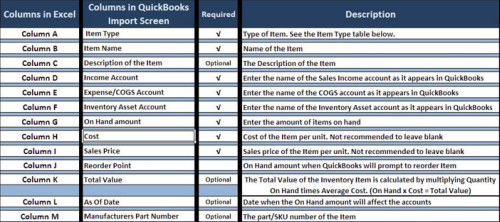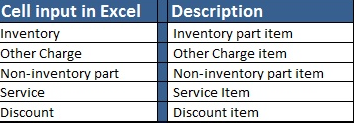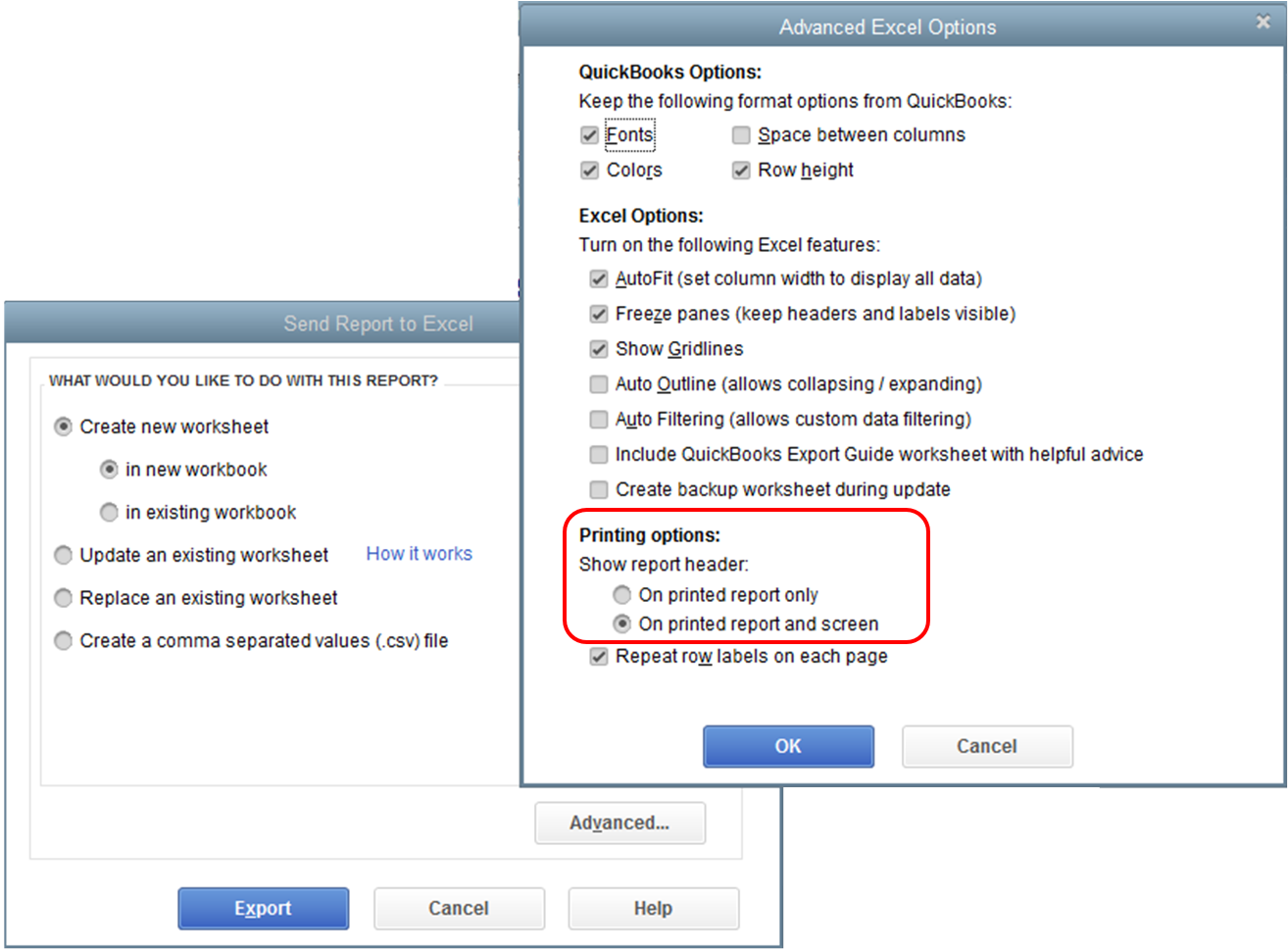How To Export Check Register To Excel In Quickbooks 2016
Learn how to import and export QuickBooks data with MS Excel files.
Y'all can import and export various listing and transaction types to and from QuickBooks Desktop using different file formats.
Import Excel files
Yous can import Customer, Vendor, Items, and Chart of Accounts from an Excel spreadsheet. There are several options bachelor when importing Excel files from QuickBooks.
Option 1: Standard import
QuickBooks opens a formatted Excel spreadsheet where y'all can enter your data. When you salvage and shut the file, you tin can review results and view your data in QuickBooks. To import Customers, Vendors, and Products yous sell
- Go to theFile menu, selectUtilities soImport and and so Excel Files.
- If you get the Add together/Edit Multiple List Entries window, click No.
- Follow the magician in importing files.
- Select the type of information.
- QuickBooks opens a formatted excel spreadsheet. In one case yous accept entered your information, saved the file and closed it, you volition exist given the option to Add together My Information At present.
- Review results and view Data in QuickBooks.
- Select Close when done.
Note: If you lot need to import additional client, vendor or item data from excel using this pick, you can always go dorsum to this window.
To import Nautical chart of Accounts
Notation: Earlier importing, we recommend that you lot create a fill-in of your company file .
- Become to the Lists menu, then selectChart of Accounts.
- Select the Account driblet-down at the bottom, and so cull Import from Excel.
- Select Browse to select the Excel file you desire to import.
- Select the file, then select Open up.
- Select the Excel Sheet where the data you want to import is on.
- Map your accounts.
Mapping your accounts tell QuickBooks how to import the data from your Excel sheet. The column headings in QuickBooks may be different from your Excel, then you'd demand to match them.
- Type in a mapping proper noun.
- Select Account every bit Import type.
- Lucifer the data under QuickBooks with the column headings in your Excel canvass.
- Select Salve.
- Select Import. If information technology's your kickoff fourth dimension to import, select Aye to confirm the process.
Selection 2: Advanced import
For items
Follow the steps below if yous are importing items and you do not accept an Excel or CSV file even so.
| Reminders:
|
Footstep one: Turn on inventory preferences
- Sign in to your company file as Admin.
- Make certain you are on the Unmarried-user mode.
Note: On the File menu, an selection to Switch to Multi-user Manner should be available. If non, select Switch to Single-user Mode. - From the QuickBooks Edit menu, select Preferences.
- Select Items & Inventory on the left pane, and so go to the Visitor Preferences tab.
- Select the Inventory and Purchase Orders are Agile checkbox, then select OK.
Step 2: Set accounts in your data file
- From the Lists card, selectChart of Accounts.
- Right-click anywhere in the Nautical chart of Accounts so select New.
- SelectAccount Type. For this step, you need to create the post-obit account types:
- Income Account to track sales.
- Price Of Appurtenances Sold (COGS) Account.*
- Inventory Asset Account.*
Step three: Create your information with the post-obit for each particular:
- Detail Name: Proper noun you want on your item list.
- If you are importing Sub-Items, the Parent item must either already exist in the Item Listing or exist above the Sub-particular, in the list gild, on the spreadsheet you lot are importing.
- If you lot are importing Sub-Items, the Item Proper name would be formatted with the Parent separated from the Sub-Detail past a colon.
Example:
Widgets
Widgets:Widget001
Widgets:Widget002
Widgets:Widget003
- Item Blazon: Include the type of item, i.e. inventory part, service, etc. Item name must exist spelled out just as you lot see it in QuickBooks.
- Description of the Item: Written description of the item that volition appear in the Item List, Sales Orders, Sales Receipts, and Invoices.
- Income Account: Name of the Income Account in which sales of the detail volition exist recorded.
- Inventory Asset Account: Proper name of the Asset Account in which the inventory value will be recorded.
- Name of the COGS Account: Proper noun of the COGS Account in which purchases of the particular will be recorded.
- On Paw Quantity: The Quantity On Hand of the Item (Inventory Items but).
- Cost of Item: The Price of the Item.
- Sales Cost: Sales Price of the Particular.
- Total Value: The Total Value of the Particular (New Inventory Items only).
- As Of Date: When the Item was concluding purchased (New Inventory Items but).
- Is Passed Thru: Be sure that you put a Y in this cavalcade so y'all can track both the cost and toll of the item.
Important: You must use the same name, spelling, and capitalization equally it appears in the Nautical chart of Accounts.
Optional Information:
- Manufacturers Part Number or SKU: You can as well import the part/SKU number of an item.
- Reorder Betoken: Once the Item On Hand count reaches this amount, QuickBooks will prompt you to reorder more Items.
Stride 4: Create the spreadsheet
Create the spreadsheet using these tables as guides:


![]()
Step 5: Prepare to import
Make sure you know the location of the Excel spreadsheet file. QuickBooks will sync with the spreadsheet during the process.
- Get-go QuickBooks.
- Open your company data file.
- Back upwardly the QuickBooks company file without overwriting any previous backup.
Stride 6: Import the spreadsheet
- Go to theFile menu, selectUtilities and then Import and then Excel Files.
- On the Add/Edit Multiple List Entries, selectNo.
- SelectAdvanced Import.
- Setup a mapping.
- SelectBrowse and choose the Excel file.
- Choose the correct sheet in the Excel workbook.
- Select theThis data file has header rows checkbox to identify the available headers from your file.
- On theCull a mapping dropdown, select Add together New.
- On the Mappings window:
- On the mapping name field, type a name to easily identify the mapping (Customer, Vendors, etc…).
- From the Import type dropdown, cull the data you are importing.
- Match the QuickBooks and Import Data columns, then select Save.
Annotation: QuickBooks column displays the available client fields in QuickBooks and Import Data column displays the available row headers on your Excel file. If y'all don't accept information from your file that will lucifer the fields in QuickBooks, leave it blank. - SelectPreview to verify the mapping.
- SelectImport to consummate the import.
- If you receive the Duplicate Tape Found mistake, yous volition exist presented with these options:
- Keep the existing data and discard the import information.
- Replace the existing data with import data, ignoring blank fields.
- Replace the existing data with import data, including blank fields.
To gear up the errors:
- Choose the appropriate option.
- SelectApply or Apply to all.
- You will receive a notification indicating the number of successful imports and the number of errors. If you take errors, select Save for the error log and review information technology to determine the necessary action to resolve the errors.
- Re-import list as needed.
For customers, vendors, and other lists information
Use this option if you are importing Customers, Vendors, Items and other lists data and you have an Excel file or CSV data already formatted for QuickBooks.
- From the File menu, selectUtilities so Import and then Excel Files.
- On the Add/Edit Multiple List Entries, selectNo.
- SelectAdvanced Import.
- Ready up a mapping.
- SelectBrowse and choose the Excel file.
- Choose the correct canvass in the Excel workbook.
- Select theThis data file has header rows checkbox to identify the available headers from your file.
- On the Choose a mapping dropdown, select Add New.
- On the Mappings window:
- On the mapping proper noun field, type a name to hands identify the mapping (Customer, Vendors, etc…)
- From the Import blazon dropdown, choose the data you are importing.
- Friction match the QuickBooks and Import Data columns, then select Save.
Annotation: QuickBooks column displays the available customer fields in QuickBooks and Import Data cavalcade displays the available row headers on your Excel file. If you lot don't have data from your file that volition match the fields in QuickBooks, get out it bare. - SelectPreview to verify the mapping.
- SelectImport to complete the import.
- If you receive the Duplicate Record Found error, you will be presented with these options:
- Keep existing data and discard import data.
- Supersede existing data with import information, ignoring blank fields.
- Replace existing data with import data, including blank fields.
To fix the errors:
- Cull the advisable option.
- SelectApply or Use to all.
- You volition receive a notification indicating the number of successful imports and the number of errors. If you have errors, select Save for the error log and review it to determine the necessary action to resolve the errors.
- Re-import list as needed.
Option three: Add together/Edit Multiple Lists
This option allows you lot to add and edit multiple customers, vendors, and items. This is for list information (name, description, etc.) and cannot be used to import transactions (invoices, bills, etc…).
- From the Lists menu, select Add together/Edit Multiple Listing Entries.
- Select the List dropdown and choose the list you desire to work with.
- Filter the list to come across a detail record.
- (Optional) Select the Customize Columns button to cull which columns you want to run into in the Add together/Edit Multiple List Entries window. This way, you can easily piece of work on the columns you need. Select the Default button to render to the preset columns for the listing.
- To add: from the left pane, select a cavalcade and selectAdd together.
- To remove: from the right pane, select a column and selectRemove.
- To rearrange the cavalcade gild: from the right pane, select the column and selectMotion Up or Move Down.
- SelectOk.
Note: Columns like customer or vendor proper name are required and cannot be removed. You can only alter their order.
- Add or edit the entries by clicking the advisable fields. Annotation that you tin copy (Ctrl+C) data from Excel and paste (Ctrl+V) information technology into this window. You tin can also Copy downward and Duplicate rows (highlight any field and select Copy Down and Indistinguishable Row)
- SelectSave Changes.
After saving your changes, y'all volition receive a warning telling yous the number of records saved. QuickBooks will also tell you if in that location are errors that need to be fixed.
To fix the errors:
- Click or hover your mouse in any field to meet what the error is.
- Update the record to fix the errors.
- Select Save Changes and echo the procedure until all errors are stock-still. Note that if yous don't desire to fix an fault, yous tin save the changes yous've made and so far and selectClose without making further changes. QuickBooks will non salve the changes that incorporate errors.
Export Excel files
You tin export Customer, Vendor, Payroll lists and transactions, as well equally Items listing into an Excel spreadsheet. If y'all need to change a report's advent or contents in ways that are not bachelor in QuickBooks, you tin can also export reports and customize it in Excel without affecting your QuickBooks data.
Client/Vendor/Payroll list and transactions
- Open the Client/Vendor/Payroll heart.
- SelectExcel drop-down and choose:
- Export Client/Vendor/Employee listing if you desire to consign customer/vendor/employee data such every bit proper name, balances and contact information.
- Consign Transactions if you lot want to consign transactions (either past name or transaction type).
- In the Export window, choose whether to create a new worksheet or update an existing worksheet.
- Select the Export button. QuickBooks opens MS Excel and you lot tin edit the information equally needed.
Items
- Go to theLists card, select Detail List.
- On the Excel dropdown, choose Export all Items.
- In the Export window, choose whether to create a new worksheet or update an existing worksheet.
- Select the Export push button. QuickBooks opens MS Excel. Yous can edit the information as needed.
Reports
Information that QuickBooks exports to Excel include:
- Data in the written report, as it is displayed on the screen
- Formula for subtotals, totals, and other calculations
- Row labels that describe the contents of each row
- Headers and footers from the QuickBooks written report
- Open the written report you desire to export.
- Select the Excel drop-downwardly at the elevation of the report, then select Create New Worksheet or Update Existing Worksheet.
- In the Send Written report to Excel window, choose what yous'd similar to practise with the report.
- Select the Advanced push button to see other available options for the exported written report and so selectOK. To ensure the exported report will bear witness Header information
If you are using a newer version of MS Excel and the exported study does non show header data, go to the Press options section and brand sure the On Printed report and screen selection is selected.

- Select the Export push. QuickBooks opens MS Excel. You can edit your data as needed.
Source: https://quickbooks.intuit.com/learn-support/en-us/help-article/list-management/import-export-ms-excel-files/L9BDPsTTX_US_en_US
Posted by: marrowabeatice.blogspot.com


0 Response to "How To Export Check Register To Excel In Quickbooks 2016"
Post a Comment